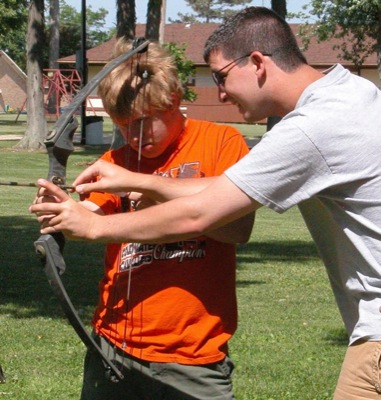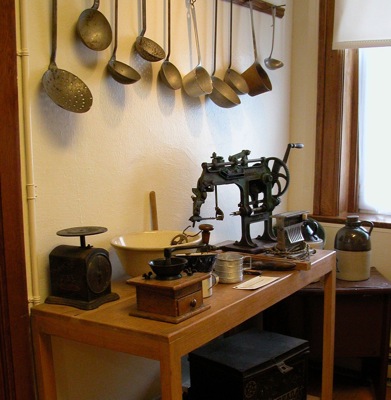Friday, June 8th, 2007
State ag director: SWCDs should lead in pollution fix
By Nancy Allen
The Ohio Department of Agriculture wants local county soil and water conservation districts to take the lead in fixing agriculture pollution problems caused by small and medium-sized farms.
If problems persist, the ODA may be forced to enact stricter regulations, said ODA director Robert Boggs during Thursday's monthly agriculture breakfast in Celina.
"There is a problem with (manure) runoff from livestock operations, there's no question. And it's not the large operations, it's the small and medium operations," Boggs said. "Let's solve these problems (locally) before we have to enforce."
Boggs, newly appointed under Governor Ted Strickland, spoke to a crowd of about 60 Thursday during the breakfast. The visit was arranged by state Rep. Jim Zehringer, R-Fort Recovery.
Boggs said soil and water conservation districts should stand up to the few problem producers, adding that it is those operators that make it tough for all livestock farmers.
He praised state Rep. Jim Zehringer, R-Fort Recovery and Senator Keith Faber for their leadership and helping add more money to the state budget for local SWCDs.
Boggs said to lessen manure runoff problems, the ODA plans to create a memorandum of understanding between the Ohio Department of Natural Resources (ODNR) and ODA that would allow the ODA to better target problem producers and work with legislators on the issue. He also is looking at amending existing rules for large, state-permitted livestock operations to include wider filter strips along waterways in sensitive areas.
The ODNR's Division of Soil and Water Conservation already has a similar memorandum of understanding with the state's 88 county SWCDs allowing SWCDs to refer problem offenders for enforcement. Boggs said he will push for more followthrough on this .
Boggs also said large, state permitted confined animal feeding operations (CAFOs) are necessary in Ohio to retain the state's place in agricultural production. These farms can be home to thousands of cattle and hogs and millions of poultry. CAFOs have strict manure management rules and are inspected by the state.
The ODA has some of the toughest environmental regulations for large permitted livestock operations in the nation, even tougher than the U.S. EPA, Boggs said.
The Wabash River and Grand Lake watersheds have been deemed among the most degraded in the state, Ohio EPA water quality testing has shown. The main cause is runoff from farmland, which makes up more than 90 percent of the acreage in the livestock-heavy watersheds, data shows.
Excess nutrient runoff into the 13,500-acre Grand Lake feeds blue-green algae, which is present in the lake year-round. It gives the lake its perpetually, cloudy, green color. Lake groups in recent years have stepped up pressure, urging local SWCDs to act on the matter and lobby for state and federal funds to pay for conservation practices that improve water quality.
Boggs said the possible number 1 challenge facing Ohio agriculture is protecting the animal life and food supply, which is under almost daily attack.
"Recently we caught some alfalfa sprouts that had contacted with salmonella ... Every day there is something happening in ODA labs," he said.
The ODA also is working with the Ohio State University Extension to increase direct marketing by producers to give the public access to locally-grown food, including organic food, through roadside stands and farmers markets, he said.
Boggs said the ODA needs to do more to preserve farmland, noting the state has saved more than 20,000 acres over the past five years, but lost one million.
The ODA also will make local farmers more aware of state institutions to sell their products, in an attempt to get more Ohio-grown foods into those institutions.
The ODA also will do more to promote and support bioproducts that come from plants grown in Ohio to make clothing and other products, he said. Many bio-based products have been replaced with pertoleum-based products. The ODA is talking with biorefineries in Ohio that refine soy and corn into biomanufacturing stock that can be made into polymers.
Boggs said the current biofuels revolution occurring in the state is a problem for livestock farmers.
Livestock farmers are experiencing unprecedented feed prices due to the increase in demand for corn for ethanol production. ODA needs to work with OSU Extension and OARDC on new research to help farmers produce more soybeans and corn per acre to keep up with demand, he continued.
Boggs and his staff visited various sites throughout the county in a tour also attended by Zehringer, Faber and Mercer County Farm Service Agency Executive Director Chris Gibbs. Stops included VanTilburg Farms north of Celina, a soybean extrusion plant under construction at Mercer Landmark in Rockford, the Hellwarth family dairy northeast of Celina, Cooper Farms mill in Fort Recovery, Fort Recovery High School vocational ag lab, Fort Recovery Equity, and the Grand Lake watershed south of the lake.



